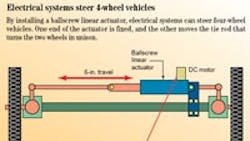Electric steering drives replace hydraulic units
To the owners and operators of fork lift trucks, ergonomics continues as an important issue. Common sense tells us that truck operators should be able to avoid physical contortions so they don’t bang their knees against steering columns. Also, federal and local noise restrictions limit noisy equipment, and increasing productivity requires longer operational periods between battery charges.
As truck designers put all these requirements together, they know they must start with a blank piece of paper when designing some vehicles parts. Vehicle steering is often in that category. The steering column is being declared posta non grata. The common 3-hp hydraulic pump supplying steering power is also on the expendable list. And so it goes.
The marks put on the blank page that form the new designs often include electrical steering, Figure 1. This replaces mechanical, hydraulic, and hydraulically assisted steering systems. Although electrical systems offer many advantages, some feel that relying on racing electrons instead of flowing oil molecules raises questions — some say fears — about safety. Therefore, safety and reliability constraints necessitate a steering system that checks itself to assure it is operational before a truck can start, and it continues to check while the truck is in motion.
Electrical solution
Various types of electrical steering systems are entering the market place, some are designed by the truck manufacturers themselves, others by motion control equipment manufacturers. One such steering system that has found acceptance in both European and domestic markets was developed by Atlas Copco Controls. This system replaces a hydraulic steering motor (or mechanical linkages) with a dc permanent-magnet motor, Figure 2. A tachometer-generator (tach), about the size of your fist, and two control wires replace the steering-wheelcolumn combination.
To tune the truck’s characteristics to the operator, a steering ratio can be selected to produce the desired angular movement of the steerable wheel per revolution of the operator’s steering wheel.
Some designs — typically on reach trucks, which move vertically as well as horizontally — use a joy-stick rather than a tach for an operator interface. This, too, relies on wires rather than hoses.
Emerging ergonomics
By removing any direct mechanical connection between operator’s steering control and the steerable wheels, the operator’s steering control can be mounted in any one of several locations. Some designs place the “steering wheel,” which is now 2 to 3 in. in diameter, on a tiltable arm that can be raised when the driver mounts and dismounts the truck, Figure 3.
This versatility removes the causes for sore joints and muscles produced by trying to avoid hitting the steering column and bruised knees produced when the avoidance attempts fail.
Noise abatement
With a hydraulic steering system, a 3-hp pump continuously produces the needed hydraulic pressure, but it also generates significant noise, depending upon the unit, usually between 6 and 10 dBm. “By using electrical drives for steering, the pump noise is eliminated, which frequently brings the total vehicle noise level within compliance,” stated Bjorn Karlstrom, president of Atlas Copco Controls.
According to recent surveys, in Europe noise reduction was the third most important benefit of electrical steering systems and first in the United States.
Productivity producer
By eliminating the auxiliary pump operation, both noise and power consumption are significantly reduced. Specifically, a constant speed 3-hp pump is replaced with a 1/4-hp dc motor. Moreover, the dc motor runs only when the wheel is turning to change direction of travel. Result: The power for the steering function is cut by up to 90%. This load reduction lengthens the time between battery charges, sometimes by hours.
Continue on page 2
Safety assurance
When the truck is turned on but before it moves, the steering controller sends voltage pulses to its own circuitry, the motor, and to the tach. The controller then compares the resulting current wave form (determined by the circuit resistance and inductance) with a known standard, which has been established in the controller. According to Atlas Copco’s Product Sales Manager, Ray Rebholz, “If there is any deviation in the current wave form from the standard, the steering controller prevents the traction drive controller from releasing the holding brakes and energizing the traction motors.”
The safety circuit continuously monitors the same components during truck operation. Again, any deviation of the current wave form causes the controller to shut the traction drive down and apply the holding brakes.
Trends
According to Mr. Karlstrom, the fork lift truck industry is slowing following the automotive manufacturers in adopting distributed control systems. In these, control components communicate peerto- peer via a CAN network. (For more on CAN networks, see PTD, 7/94, p 19.) Such vehicle networks, Figure 4, offer the ability to:
• Limit turning radius and speed as a function of load.
• Change vehicle steering and operating characteristics to fit individual operators.
• Offer diagnostics that can pinpoint a faulty component.
• Enable a vehicle to turn with a radius that is less than its own length. While the steerable wheel is at maximum rotation, the microprocessor commands one wheel to rotate clockwise and the other to rotate counterclockwise.
• Report on operator’s driving characteristics at the end of a shift or other time period.
In addition to fork lift trucks and similar industrial vehicles, Mr. Karlstrom foresees similar electric steering systems being applied to military vehicles, off-road (terrain) vehicles, and other applications requiring an ergonomic solution.
